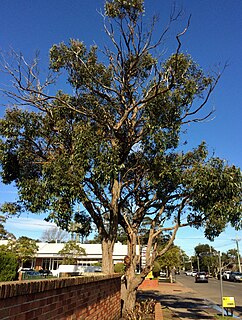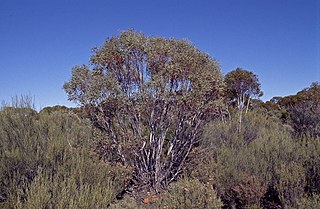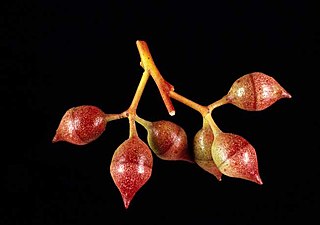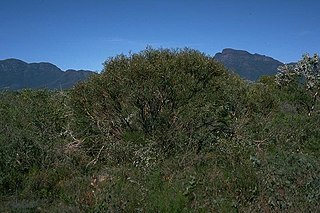
Eucalyptus caesia, commonly known as caesia or gungurru, is a species of mallee that is endemic to the south-west of Western Australia. It has smooth reddish brown bark at first, later shedding in curling flakes, lance-shaped, sometimes curved adult leaves, club-shaped flower buds covered with a waxy, bluish white bloom, pink stamens with yellow anthers and urn-shaped fruit.

Eucalyptus macrandra, commonly known as long-flowered marlock, river yate or twet, is a species of mallee or small tree that is endemic to the south-west of Western Australia. It has smooth greyish bark, lance-shaped adult leaves, flower buds usually in groups of fifteen, pale yellow flowers and elongated cup-shaped to bell-shaped fruits.

Eucalyptus pleurocarpa, commonly known as tallerack, talyerock or tallerack is a species of mallee that is endemic to the southwest of Western Australia. It has smooth bark, broadly lance-shaped to elliptical, grey or glaucous leaves that are arranged more or less in opposite pairs, flower buds in groups of seven, whitish flowers and glaucous, barrel-shaped fruit. It is easily recognised in the field by its form, large, white, waxy leaves and, when in flower, its stamens clustered in four groups.

Eucalyptus macrorhyncha, commonly known as the red stringybark, is a species of medium-sized tree that is endemic to eastern Australia. It has rough, stringy, grey to brown bark, lance-shaped adult leaves, flower buds in groups of between seven and eleven, white flowers and hemispherical fruit.

Eucalyptus grossa, commonly known as coarse-leaved mallee, is a species of mallee or rarely a straggly tree, that is endemic to Western Australia. It has rough, fibrous bark on the trunk and all but the thinnest branches, broadly lance-shaped to egg-shaped adult leaves, flower buds in groups of seven, yellowish green flowers and cup-shaped to cylindrical fruit.

Eucalyptus baxteri, commonly known as brown stringybark, is a medium-sized tree that is endemic the south-east of Australia. It has rough, stringy bark to the thinnest branches, lance-shaped or curved adult leaves, green to yellow flower buds is groups of between nine and fifteen and cup-shaped or hemispherical fruit.

Eucalyptus loxophleba, commonly known as York gum, daarwet, goatta, twotta or yandee is a species of tree or mallee that is endemic to Western Australia. It has rough bark on the trunk, smooth olive to brownish bark above, lance-shaped adult leaves, flowers buds in groups of between seven and eleven, white flowers and conical fruit.

Eucalyptus leptopoda, commonly known as the Tammin mallee, is a species of mallee or rarely a tree, that is endemic to Western Australia. It has smooth mottled grey or brownish bark, sometimes with rough bark near the base, linear to curved adult leaves, flower buds usually in groups of seven and eleven, creamy white flowers and hemispherical to flattened spherical fruit.

Eucalyptus annuliformis, commonly known as the Badgerabbie mallee, is a rare mallee that is endemic to a small area in the south-west of Western Australia. It has smooth, greyish bark, elliptic to lance-shaped leaves when mature, oval flower buds, white flowers and hemispherical fruit with a broad disc.

Eucalyptus arachnaea, commonly known as the black-stemmed mallee, is a mallee or tree that is endemic to Western Australia. It has rough, stringy bark, lance-shaped leaves and white flowers in groups of up to thirteen.

Eucalyptus micranthera, commonly known as the Alexander River mallee or milkshake mallee, is a species of mallee that is endemic to a small area along the south coast of Western Australia. It has smooth bark, lance-shaped adult leaves, flower buds in groups of seven or nine, creamy white flowers and more or less hemispherical fruit.
Eucalyptus obesa, commonly known as the Ninety Mile Tank mallee, is a species of mallee that is endemic to Western Australia. It has smooth, greyish to pale brown bark, usually lance-shaped adult leaves, flower buds in groups of between eleven and fifteen, creamy white flowers and shortened spherical to hemispherical fruit.

Eucalyptus pachyloma, commonly known as Kalgan Plains mallee, is a species of mallee that is native to Western Australia. It has smooth, greyish bark, lance-shaped adult leaves, flower buds in groups of between seven and thirteen, white to cream-coloured flowers and conical to cup-shaped fruit.

Eucalyptus rigidula, commonly known as stiff-leaved mallee, is a species of mallee that is endemic to Western Australia. It has smooth bark, linear to narrow elliptic or narrow lance-shaped leaves, flower buds in groups of nine or eleven, creamy white flowers and barrel-shaped to hemispherical fruit.

Eucalyptus scyphocalyx, commonly known as goblet mallee, is a species of mallee that is endemic to southern areas of Western Australia. It has smooth bark, lance-shaped adult leaves, flower buds in groups of three or seven, creamy white flowers and cup-shaped to cylindrical fruit.

Corymbia grandifolia, commonly known as the cabbage gum, large-leaved cabbage gum and the paper-fruited bloodwood, is a species of tree that is endemic to northern Australia. It has smooth bark, egg-shaped to broadly elliptic to lance-shaped adult leaves, flowers buds in groups of three or seven, creamy white flowers and cup-shaped to cylindrical fruit.

Corymbia peltata, commonly known as yellowjacket or rustyjacket, is a species of small to medium-sized tree that is endemic to Queensland. It has rough, tessellated bark on the trunk and larger branches, smooth yellowish bark above, a crown of mostly juvenile egg-shaped to round leaves, flower buds in groups of seven, white flowers and barrel-shaped, urn-shaped or shortened spherical fruit.

Eucalyptus conglobata, also known as the cong mallee or Port Lincoln mallee, is a species of eucalypt that is native to the south coast of Western Australia and South Australia. It is a mallee with smooth bark, lance-shaped adult leaves, flower buds in groups of seven, white flowers and clustered hemispherical fruit.
Eucalyptus infera, commonly known as the Durikai mallee, is a species of mallee, rarely a small tree, that is endemic to Queensland. It has smooth grey bark, broadly lance-shaped to egg-shaped leaves, flower buds in groups of between nine and eighteen, white flowers and hemispherical fruit.
Phebalium drummondii is a species of small shrub that is endemic to Western Australia. It has smooth branchlets covered with silvery scales, broadly elliptic to egg-shaped leaves with silvery scales on the lower side and bright yellow flowers arranged in umbers on the ends of branchlets.



















